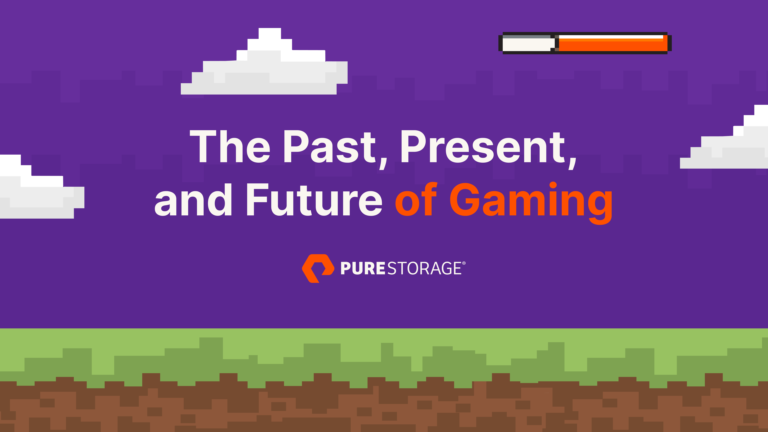At Pure, we talk a lot about data. (Naturally.) But things get really cool when we get to talk about what data can do—how it’s fueling creativity, innovation, and fun. Video games have been a testing ground and showcase for technology since a physicist invented the first game in 1958. Today, they’re on the bleeding edge of emerging technologies, from AI and blockchain to virtual reality and wearables. Behind it all? Massive amounts of data and analytics.
Today is National Video Games Day, and It just so happens two people of Pure—Ralph Ronzio and Sam Marraccini—love retro games. We sat them down to reminisce about games and how far they’ve come.
They May Be Virtual, But Gaming is Still Social
Video games and hanging out have always gone hand in hand. What started as a way to meet up—in department stores, pizza parlors, or arcades—came home with consoles and personal computers. Today, we can play anywhere on our phones and with people on the other side of the globe.
That’s not all. Games themselves have evolved to become community-driven “experiences,” paving the way for the metaverse and online communities of Web 3.0. It’s no longer just about playing—it’s about immersive engagement, monetization opportunities, and events, such as concerts. Delivering the same real-time experiences to millions of players online at a given time requires phenomenal latency and reliability.
How We Pay to Play Has Come a Long Way
From waiting in line with a cup of quarters to saving pennies for cartridges, how we purchase games hasn’t just changed. Games have become their own thriving economies.
The subscription economy is everywhere these days, and Marraccini predicts gaming will be a huge use case. “It’s the evolution to as-a-service, which we talk about all the time in terms of storage,” says Marraccini. “You see it with things like Game Pass, where you pay a certain amount a month to be able to download and play any game.”
No more cartridges also means you’re not messing with the storage of, maintenance of, and investment in games you no longer need. Cloud-based streaming removes the need to download. “The box kind of becomes more of like a transport mechanism,” adds Ronzio. “And all of the processing is happening in the cloud.”
AI and Tool-assisted Speedruns Take Gameplay Beyond Human Limits
Remember the kid in the arcade no one could beat? In the modern gaming world, players don’t just use skills to play—they can use AI to make inputs that execute frame-perfect decisions. The result is more like machine vs. machine, showing play beyond the human limits that beats the game as fast as possible. Creators build out tool-assisted speedrun (TAS) with the best AI tools available to show what’s possible in their favorite games.
But don’t underestimate the power of great hand-eye coordination. In the classic falling-block game Tetris, only AI had been able to reach the final “kill screen,” until now. (A kill screen is what happens when a game is pushed beyond its programming limits.) In late December 2023, a 13-year-old gamer achieved the impossible by reaching the kill screen using only his bare hands. Nobody knows which AI feat will be dethroned next, but players are getting close in Super Mario Bros.
Modern Games Represent the Best in Next-gen Visual Effects
Even though we just talked about the staying power of Tetris, you can’t ignore how far games have come in terms of visuals and performance. Technical improvements, like processing power, graphics engines, predictive and randomized gameplay, are next-level. Ralph recalls, “The arcade was the place to play. Games looked the best and sounded the best. Then, over time, the consoles just got better and better. You could play them at home and they looked exactly the same.”
Things kept evolving. Sam adds, “From 8 to 16 to 32 bits—we stopped talking about bits at some point because they don’t matter once you get to a certain place.” Rendering engines and GPUs have transformed visuals, even those that pay homage to retro, pixelated styles.
Behind the Scenes, Player Experience Has Improved, Too
Hyper-realistic worlds aside, Ronzio says being able to save your place still might be the best improvement over the old days: “It changed everything to be able to go in and load your progress and start off where you were—that was the coolest in the world. When you pick up right where you left off, that’s all data, kids! With NES, when you powered that thing off, you were done—unless you had a cheat code.”
Gameplay and competition are more sophisticated, too. We used to watch over other players’ shoulders to gauge their skills. Now, AI and analytics can match you with players of similar skill sets, while apps like Porofessor.gg harvest data to give you an idea of the players you’re up against.
In-game Transactions, NFTs, and Pay-to-Play Models Are Driving Monetization
We’ve come a long way from cups of quarters. Revenue is generated long after the initial purchase with microtransactions like in-game assets and upgrades. On the flip side, players can earn real-world value with play-to-earn models. Using virtual wallets, assets could be transferable between games.
”Imagine in original Zelda when you earned items like bombs or swords,” Ronzio hypothesizes. “The value wouldn’t be transferable to another game, like Mario Bros. But with non-fungible tokens (NFTs) and tokens, once you buy an in-game asset, it’s yours to use in other games.”
An example: Say you defeat a certain creature. The game could mint that as a unique NFT you can own in your collection. Ultra-rare enemies would be worth more and can be valuable additions to NFT collections.
Data Is Driving the Future of Gameplay and Game Development
Video games and data go hand in hand. Today, that means a slightly different thing than bits and bytes—it’s more like petabytes and rapidly distributing that data on a global scale.
“The more bandwidth you have, the more data you can push. When you can access more information, you’re going to be able to provide real-time experiences where you can almost change the game on the fly,” says Ronzio. It will continue to make games incredibly responsive and personalized. “There’s so much data. You’re collecting information about where the character is, what it’s doing, what’s its level, what skills the player has,” he says.
That requires a powerful data infrastructure.
Many games leverage containers, which allow them to update modules and improve bugs on the fly. In the days of consoles and cartridges, “They had to take chips out and put new chips in,” Ronzio says. “The likelihood of them wanting to do that was pretty low, and it might even cost the arcade operator money to put the new chips in.”
Today, games can be shipped that aren’t even technically finished. “When it arrives, they’ll do a day zero or day one update and patch the game before someone even plays it. It immediately makes a connection and downloads that update. You couldn’t do that with a cartridge.”
What Does the Future Hold?
The evolution of gaming is a perfect microcosm of the evolution of technology and computing. Notes Ronzio, “If you look at some of the documentaries about technology in general, a lot of it started as gaming. But where do things go from here?”
Augmented reality, virtual realities—we’re stepping into a world Ronzio and Marraccini say is like a virtual arcade. Gaming could be a testing ground for how these technologies play out in our day-to-day lives, and we’re here for it.
“I don’t think we can stop the train of innovation,” says Ronzio. “And that’s good.”
![]()






